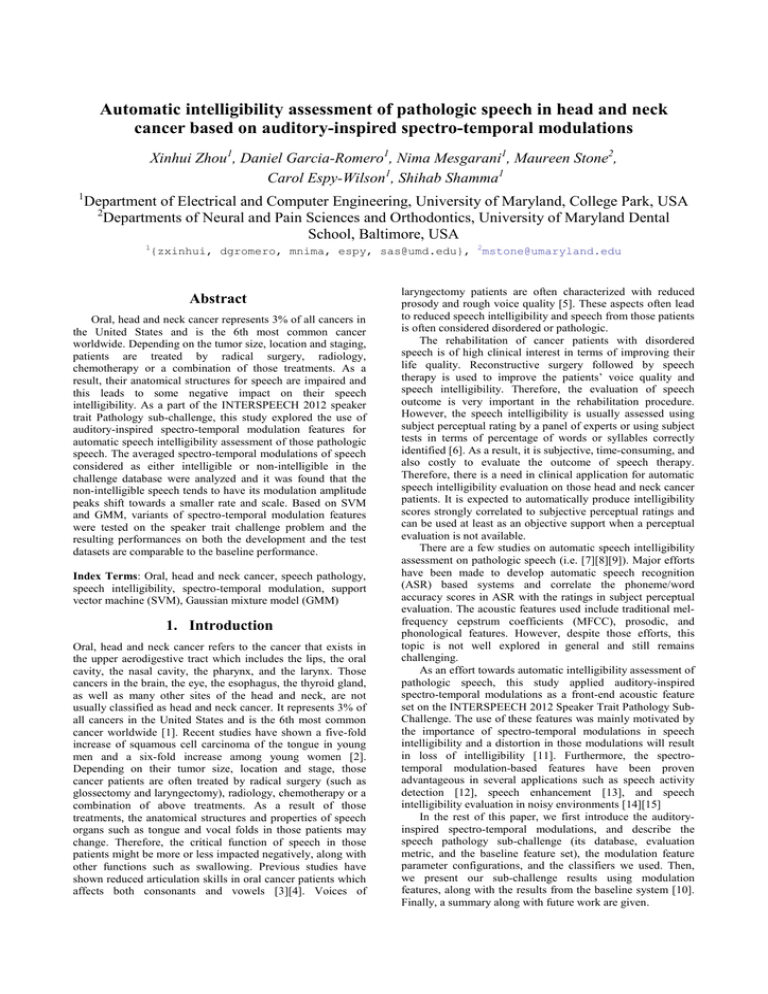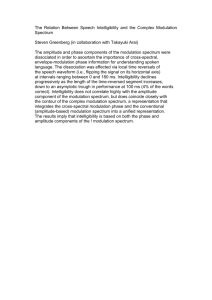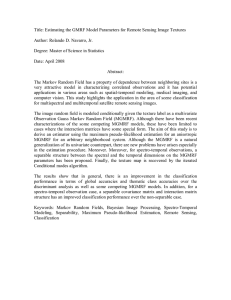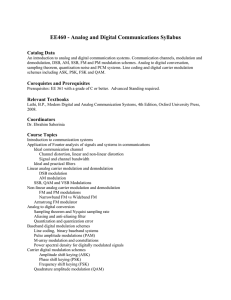Automatic intelligibility assessment of pathologic speech in head and neck
advertisement

Automatic intelligibility assessment of pathologic speech in head and neck
cancer based on auditory-inspired spectro-temporal modulations
Xinhui Zhou1, Daniel Garcia-Romero1, Nima Mesgarani1, Maureen Stone2,
Carol Espy-Wilson1, Shihab Shamma1
1
Department of Electrical and Computer Engineering, University of Maryland, College Park, USA
2
Departments of Neural and Pain Sciences and Orthodontics, University of Maryland Dental
School, Baltimore, USA
1
{zxinhui, dgromero, mnima, espy, sas@umd.edu},
Abstract
Oral, head and neck cancer represents 3% of all cancers in
the United States and is the 6th most common cancer
worldwide. Depending on the tumor size, location and staging,
patients are treated by radical surgery, radiology,
chemotherapy or a combination of those treatments. As a
result, their anatomical structures for speech are impaired and
this leads to some negative impact on their speech
intelligibility. As a part of the INTERSPEECH 2012 speaker
trait Pathology sub-challenge, this study explored the use of
auditory-inspired spectro-temporal modulation features for
automatic speech intelligibility assessment of those pathologic
speech. The averaged spectro-temporal modulations of speech
considered as either intelligible or non-intelligible in the
challenge database were analyzed and it was found that the
non-intelligible speech tends to have its modulation amplitude
peaks shift towards a smaller rate and scale. Based on SVM
and GMM, variants of spectro-temporal modulation features
were tested on the speaker trait challenge problem and the
resulting performances on both the development and the test
datasets are comparable to the baseline performance.
Index Terms: Oral, head and neck cancer, speech pathology,
speech intelligibility, spectro-temporal modulation, support
vector machine (SVM), Gaussian mixture model (GMM)
1. Introduction
Oral, head and neck cancer refers to the cancer that exists in
the upper aerodigestive tract which includes the lips, the oral
cavity, the nasal cavity, the pharynx, and the larynx. Those
cancers in the brain, the eye, the esophagus, the thyroid gland,
as well as many other sites of the head and neck, are not
usually classified as head and neck cancer. It represents 3% of
all cancers in the United States and is the 6th most common
cancer worldwide [1]. Recent studies have shown a five-fold
increase of squamous cell carcinoma of the tongue in young
men and a six-fold increase among young women [2].
Depending on their tumor size, location and stage, those
cancer patients are often treated by radical surgery (such as
glossectomy and laryngectomy), radiology, chemotherapy or a
combination of above treatments. As a result of those
treatments, the anatomical structures and properties of speech
organs such as tongue and vocal folds in those patients may
change. Therefore, the critical function of speech in those
patients might be more or less impacted negatively, along with
other functions such as swallowing. Previous studies have
shown reduced articulation skills in oral cancer patients which
affects both consonants and vowels [3][4]. Voices of
2
mstone@umaryland.edu
laryngectomy patients are often characterized with reduced
prosody and rough voice quality [5]. These aspects often lead
to reduced speech intelligibility and speech from those patients
is often considered disordered or pathologic.
The rehabilitation of cancer patients with disordered
speech is of high clinical interest in terms of improving their
life quality. Reconstructive surgery followed by speech
therapy is used to improve the patients’ voice quality and
speech intelligibility. Therefore, the evaluation of speech
outcome is very important in the rehabilitation procedure.
However, the speech intelligibility is usually assessed using
subject perceptual rating by a panel of experts or using subject
tests in terms of percentage of words or syllables correctly
identified [6]. As a result, it is subjective, time-consuming, and
also costly to evaluate the outcome of speech therapy.
Therefore, there is a need in clinical application for automatic
speech intelligibility evaluation on those head and neck cancer
patients. It is expected to automatically produce intelligibility
scores strongly correlated to subjective perceptual ratings and
can be used at least as an objective support when a perceptual
evaluation is not available.
There are a few studies on automatic speech intelligibility
assessment on pathologic speech (i.e. [7][8][9]). Major efforts
have been made to develop automatic speech recognition
(ASR) based systems and correlate the phoneme/word
accuracy scores in ASR with the ratings in subject perceptual
evaluation. The acoustic features used include traditional melfrequency cepstrum coefficients (MFCC), prosodic, and
phonological features. However, despite those efforts, this
topic is not well explored in general and still remains
challenging.
As an effort towards automatic intelligibility assessment of
pathologic speech, this study applied auditory-inspired
spectro-temporal modulations as a front-end acoustic feature
set on the INTERSPEECH 2012 Speaker Trait Pathology SubChallenge. The use of these features was mainly motivated by
the importance of spectro-temporal modulations in speech
intelligibility and a distortion in those modulations will result
in loss of intelligibility [11]. Furthermore, the spectrotemporal modulation-based features have been proven
advantageous in several applications such as speech activity
detection [12], speech enhancement [13], and speech
intelligibility evaluation in noisy environments [14][15]
In the rest of this paper, we first introduce the auditoryinspired spectro-temporal modulations, and describe the
speech pathology sub-challenge (its database, evaluation
metric, and the baseline feature set), the modulation feature
parameter configurations, and the classifiers we used. Then,
we present our sub-challenge results using modulation
features, along with the results from the baseline system [10].
Finally, a summary along with future work are given.
2. Spectro-temporal modulations
2.1. The computational auditory model
The spectro-temporal modulation features used in this
study are inspired by a computational auditory model, which is
based on neurophysiology, biophysics and psychoacoustics at
various stages of the auditory system. This auditory model
captures basic characteristics of signal processing occurring
from the early cochlear stage to the central cortical regions. It
generates a multidimensional spectro-temporal representation
of the sound. Details of this model and its applications can be
found in [16][12][13][14][15]. A Matlab toolbox on this model
is available online1.
Basically, the auditory model consists of two processing
stages:
An early auditory stage which mainly mimics the
cochlear and mid-brain signal processing and transforms
the speech into an auditory spectrogram with a series of
cochlear filters, hair cell transduction and lateral
inhibition mechanism.
A central cortical stage which analyzes the auditory
spectrogram to get a spectral and temporal modulation
profile through a series of modulation-selective filters.
The cortical analysis is essentially equivalent to a 2-D
affine wavelet transform of the auditory spectrogram.
2.2. The spectro-temporal modulation features
As the output of the auditory model, the spectro-temporal
modulation features are a multidimensional array in four
dimensions: time, frequency, temporal modulations (called
rate), and spectral modulation (called scale). The model output
is usually processed with a window size (usually 250 ms, and
a shift size varying from 150 ms to 10 ms which depends on
applications) and each window is then time-averaged, yielding
a tensor with each element representing the overall modulation
at a corresponding scale, rate, and frequency. Sufficient
number of filters is required in the model to get a full picture
of the signal. As a result, the dimensionality of the feature
space is very high (for example, 128 frequencies x ±6 rates x 5
scales = 7680) making statistical model training impractical.
Tensor principle component analysis (PCA) was applied to
perform dimensionality reduction and a feature dimension as
large as 140 was obtained [12]. Further dimensionality
reduction can be implemented using a modified linear
discriminant analysis (MLDA) in a two class classification
problem as in [15].
3. Database and Methodologies
3.1. Database for the pathology sub-challenge
The
Matlab
toolbox
is
available
http://www.isr.umd.edu/Labs/NSL/Software.htm
3.2. Feature
configurations
extraction
and
parameter
An energy-based voice activity detection (VAD) was used
to remove those silence and noisy regions in speech. The final
VAD output is the intersection of energy-based VAD and the
VAD specified by the ASR transcripts provided along with the
challenge database. Then acoustic features were extracted on
those regions specified by VAD.
Three variants of modulation features were tested in this
study: a) the 7680 dimension modulation feature with
averaging over time. This feature is to compare with the
baseline feature set provided by the Speaker Trait challenge,
b) the 140-dimension feature through a tensor PCA which is
pre-trained using the TIMIT database [12] , and c) a feature set
(60 dimensions) through further dimensionality reduction by
MLDA. The shift size in feature extraction is 100 ms for SVM
but 10 ms for GMM in order to get more feature vectors for
training.
3.3. Classifiers
The support vector machine (SVM) and the Gaussian mixture
model (GMM) are two back-end classifiers applied in this
study, depending on feature dimension and training data size.
The libSVM [19] and the MIT Lincoln Lab speaker
recognition package (for GMM training and scoring) [20] was
used respectively. A coarse grid search for optimal parameters
on both classifiers was performed. For SVM, both linear
kernel and radial basis function (RBF) kernel were tested. For
GMM, a mixture number 64 or 128 was selected due to the
limited training data.
4. Results
Details regarding the INTERSPEECH 2012 speaker trait
pathology sub-challenge and its database can be found in [10].
The “NKI CCRT Speech Corpus” (NCSC) recorded at the
Department of Head and Neck Oncology and Surgery of the
Netherlands Cancer Institute [17] was provided to the
challenge participants. This corpus contains recordings and
perceptual intelligibility evaluations of 55 speakers (10
female, 45 male) who went through concomitant chemoradiation treatment (CCRT) for inoperable tumors of the head
and neck. Based on a threshold in perceptual rating, each
utterance in the database was classified into two classes:
1
intelligible (I) or non-intelligible (NI). The whole corpus was
partitioned into three sets: the train set, the development set
and the test set. Labels (I or NI) of the first two datasets are
provided. The challenge is on the prediction of labels in the
test set, i.e., each utterance has to be determined as either
intelligible (I) or non-intelligible (NI), a two-class problem.
Unweighted average (UA) recall [18] is used as the
official evaluation measure in this challenge. In a two class
problem, recall is the computed accuracy for each class and
UA is calculated as recall(I)/2+recall(NI) /2. Weighted
average (WA) is often calculated. But UA is considered as a
better performance measure in the case of unbalanced class
distributions.
In addition, the 2012 Speaker Trait Challenge baseline
feature set was provided for comparison and it contains 6125
features for each utterance [10]. Besides the low level features
related to energy, spectra and voicing, a variety of functional
applied to low level features were added.
online:
4.1. Averaged spectro-temporal modulations of
speech in the NCSC corpus (Intelligible versus Nonintelligible)
In order to gain insight on the difference in modulation pattern
between intelligible speech and non-intelligible speech,
averaged spectro-temporal modulations in a range of rate and
scale (averaged on time and frequency axis) are computed on
the whole NCSC corpus for intelligible and non-intelligible
speech separately. For checking consistency across datasets,
train and devel sets are also computed separately. As shown in
Fig. 1, the speech modulations are bounded by the range
between 4-8 Hz in rate and < 4 cyc/octave in scale. These four
plots look very similar. However, our cross correlation study
Training set (intelligible)
Training set(nonintelligible)
8.00
8.00
8.00
8.00
4.00
4.00
4.00
4.00
2.00
2.00
2.00
2.00
1.00
1.00
1.00
1.00
0.50
- 32. - 16. - 8. - 4. - 2. - 1.
0.50
0.50
- 32. - 16. - 8. - 4. - 2. - 1.
0.50
1.
2.
4.
8.
16.
32.
Develp set (intelligible)
1.
8.00
8.00
4.00
4.00
4.00
4.00
2.00
2.00
2.00
2.00
1.00
1.00
1.00
1.00
0.50
- 32. - 16. - 8. - 4. - 2. - 1.
0.50
0.50
- 32. - 16. - 8. - 4. - 2. - 1.
0.50
2.
4.
4.
8.
16.
32.
16.
32.
Develp set(nonintelligible
8.00
1.
2.
8.
16.
32.
8.00
1.
2.
4.
8.
Figure 1. Averaged spectro-temporal modulations in the NCSC challenge database (In each plot, xaxis is rate in Hz, y-axis is scale in cyc./Octave, color indicates the modulation amplitude, Upper
panel: train set, Lower: develop set, Left : intelligible speech, right: non-intelligible speech.
shows consistently a slightly larger cross correlation
coefficient between two plots belonging to the same class than
from two different classes. Furthermore, there exists a pattern
difference between intelligible speech and non-intelligible
speech, that is, while the highest amplitude peaks in
intelligible data appears at around 4 Hz (indicated by the
dotted line), the peak amplitudes in the non-intelligible data
appear at a lower rate (< 4 Hz). This is even clearer when the
modulations are further averaged on rate or scale, as shown in
Fig. 2. It can be seen that the amplitude peak locations in nonintelligible speech tend to shift to a lower rate and scale (note
that the smallest rate in x-axis in Fig. 2a lies in the middle).
One explanation for this is that those patients with difficulty in
articulation tend to speak slowly and discontinuously.
However more future efforts are needed to understand the
fundamental difference in spectro-temporal modulations
between intelligible speech and non-intelligible speech.
4.2. Experiment results
Our preliminary experiment results on the speaker trait
challenge are shown in Table 1 which presents the recalls, the
unweighted accuracy, and the weighted accuracy for
combinations of feature sets and classifiers. The results on
both the development set and the test set are shown in Table 1.
Since the classifiers play big roles in performance, for a
fair comparison, SVM with linear kernel was applied on both
the baseline feature set and the 7,680 high dimension
modulation feature. The RBF kernel was also tested but
producing worse results than the linear kernel for the high
dimension feature. It can be seen that the 7,680-D modulation
feature performs slightly better (57.7 vs. 56.9% UA) than the
baseline feature set on the development set. This holds across
Figure 2. Averaged modulation on rate a) (from -32 to 32 in
Hz) and scale b)(from 0.5 to 8 in Cyc./Octave) in the NCSC
challenge database (intelligible or non-intelligible in training
or devel set)
a range of cost parameter C in SVM. But the difference is
small and may not be statistically significant. The 140-D
feature set was applied on both SVM and GMM. But only the
first 70 elements are used for the latter due to limited amount
of training data. In general, GMM is not as good as SVM in
this problem, which is mainly due to lacking sufficient training
data. The performance of the 140-D feature set using SVM is
comparable to the baseline performance on the devel set, 62.8
vs. 61.4% in UW.
The results on the test datasets are shown in Table 1 The
performance of 140-D modulation features using SVM is
comparable to the baseline performance, 68.3 vs. 68.4% in
UW. This shows the effectiveness of spectro-temporal
modulations as a feature set in assessment of speech
intelligibility.
Table I. The performances of modulation features in the Pathology
Sub-Challenge compared to the baseline results by unweighted and
weighted average (UA/WA) recall in percent (weighting by number
of instances per class)
7. References
[1]
[2]
[3]
[4]
[5]
[6]
[7]
The performance of modulation features on the test set can
be improved in future on several aspects. First is to optimize
the back-end classifier as done in the baseline system [10].
Cross-validation using both train set and development set
should get a more generalized classifier on the test set. Second
is to fuse the outputs from both modulation features and
baseline features based on various classifiers (SVM and
GMM) because these two sets of features may provide
complementary information. Last is to optimize the
modulation feature parameter configurations for a better
performance.
[8]
[9]
[10]
[11]
5. Summary and future work
This preliminary study applied auditory-inspired spectrotemporal modulations as a front-end acoustic feature set on the
INTERSPEECH 2012 Speaker Trait Pathology SubChallenge. This was motivated by the premise that a distortion
in spectro-temporal modulations of speech will result in loss of
intelligibility. The averaged spectro-temporal modulations of
the NCSC database were analyzed and it was found that the
non-intelligible speech tends to have its modulation amplitude
peaks shift towards a smaller rate and scale. Based on SVM
and GMM, variants of modulation features were tested on the
speaker trait challenge problem and the resulting performances
on both the development dataset and the test dataset are
comparable to the baseline system. In addition to continuing
analysis on the INTERSPEECH 2012 speaker trait challenge
in terms of acoustic parameters and classifiers optimization,
we would also like to look into fundamental issues on how
various phenomena in pathologic speech are represented in
spectro-temporal modulations.
[12]
[13]
[14]
[15]
[16]
[17]
[18]
6. Acknowledgements
This work was partially supported by a grant from DARPA
and NIH grant R01CA133015. All statements of fact, opinion,
or conclusions contained herein are those of the authors and
should not be construed as representing the official views or
policies of NIH and DARPA. The first author would like to
thank Sridhar Krishan Nemala for his help on LDA code.
[19]
[20]
American Cancer Society, facts and figures, available at
http://www.cancer.org/Research/CancerFactsFigures/CancerFact
sFigures/cancer-facts-and-figures-2010.
Annertz, K., Anderson, H., Biorklund, A., Moller, T., Kantola,
S., Mork, J., Olsen, J. H. and Wennerber, J., “Incidence and
survival of squamous cell carcinoma of the tongue in
Scandinavia, with special reference to young adults”,
International Journal of Cancer, vol. 101, pp95-99, 2002.
Sumita, Y. I., Ozawa, S., Mukohyama, H., Ueno, T., Ohyama, T.
and Taniguchi, H., “Digital acoustic analysis of five vowels in
maxillectomy patients,” Journal of Oral Rehabilitation, vol. 29,
no. 7, pp. 649–656, 2002
Zhou, X., Stone, M., and Espy-Wilson, C.Y. , “A comparative
acoustic study on speech of glossectomy patients and normal
subjects”, Interspeech 2011, August, Florence, Italy.
Furia , C.L., Kowalski, L. P., Latorre, M.R., Angelis, E. C.,
Martins, N.M., Barros, A. P. and Ribeiro, K. C., “Speech
intelligibility after glossectomy and speech rehabilitation”, Arch.
Otolaryngol. Head Neck Surg., vol. 127, pp. 877-883, 2001.
Bressmann , T., Sader, R., Whitehill T. L. and Samman, N.,
“Consonant intelligibility and tongue motility in patients with
partial glossectomy”, International Journal of Oral and
Maxillofacial Surgery, vol. 62, pp. 298-303, 2004.
Bocklet, T., Riedhammer, K., Nöth, E., Eysholdt, U., Haderlein,
T. J., “Automatic Intelligibility Assessment of Speakers After
Laryngeal Cancer by Means of Acoustic Modeling”, J. Voice.
2011 Aug 4.
Maier, A., Haderlein, T., et al., “Automatic Speech Recognition
Systems for the Evaluation of Voice and Speech Disorders in
Head and Neck Cancer”, EURASIP Journal on Audio, Speech,
and Music Processing, Article ID 926951, 2010.
Windrich, M., Maier, A., Kohler, R. et al., “Automatic
quantification of speech intelligibility of adults with oral
squamous cell carcinoma,” Folia Phoniatrica et Logopaedica,
vol. 60, no 3, pp. 151–156, 2008.
Schuller, B., Steidl, S., Batliner, A., Nöth, E., Vinciarelli, A.,
Burkhardt, F., Van Son, R., Weninger, F., Eyben, F., Bocklet, T.,
Mohammadi, G., Weiss, B., “The Interspeech 2012 Speaker
Trait Challenge”, Proc. Interspeech 2012, Portland, USA, 2012.
Drullman, R., Festen, J., Plomp, R., “Effect of envelope
smearing on speech perception”, J. Acoust. Soc. Am., 95 (2),
1053–1064, 1994.
Mesgarani, N., Slaney, M., and Shamma, S. A. “Discrimination
of speech from nonspeech based on multiscale spectrotemporal
modulations”, IEEE Transactions on Audio, Speech, and
Language Processing, vol. 14, 920-930, 2006.
Mesgarani, N., and Shamma, S. A., “Denoising in the domain of
spectrotemporal modulations,” EURASIP J. Audio Speech
Music Process. 3, 1–8, 2007.
Elhilali M., Chi T, Shamma S. A., “A spectro-temporal
modulation index (STMI) for assessment of speech
intelligibility”, Speech Communication, 41, pp. 331-348, 2007.
Nemala, S. K., Elhilali, M., “A joint Acoustic and Phonological
Approach to Speech Intelligibility Assessment”, the IEEE
International Conference on Acoustics, Speech, and Signal
processing, ICASSP’10, pp.4742 - 4745.
Chi T., Ru P.,Shamma S. A., “Multi-resolution spectro-temporal
analysis of complex sounds”, JASA, 118:887-906, 2005.
Van der Molen, L., Van Rossum, M., Ackerstaff, A., Smeele, L.,
Rasch, C. and Hilgers, F., “Pretreatment organ function in
patients with advanced head and neck cancer: clinical outcome
measures and patients’ views”, BMC Ear Nose Throat Disorders,
vol. 9, no. 10, 2009.
Schuller, B., Batliner, A., Steidl, S., and Seppi, D., “Recognising
realistic emotions and affect in speech: State of the art and
lessons learnt from the first challenge”, Speech Communication,
vol. 53, no. 9/10, pp. 1062–1087, 2011.
Chang, C. C. and Lin, C. J., “LIBSVM: a library for support
vector machines”, ACM Transactions on Intelligent Systems and
Technology, 2:27:1-27:27, 2011.
Sturim, D. E., Campbell, W. M., Karam, Zahi N., Reynolds, D.,
Richardson, F. S. (2009), “The MIT lincoln laboratory 2008
speaker recognition system”, INTERSPEECH2009, 2359-62.



